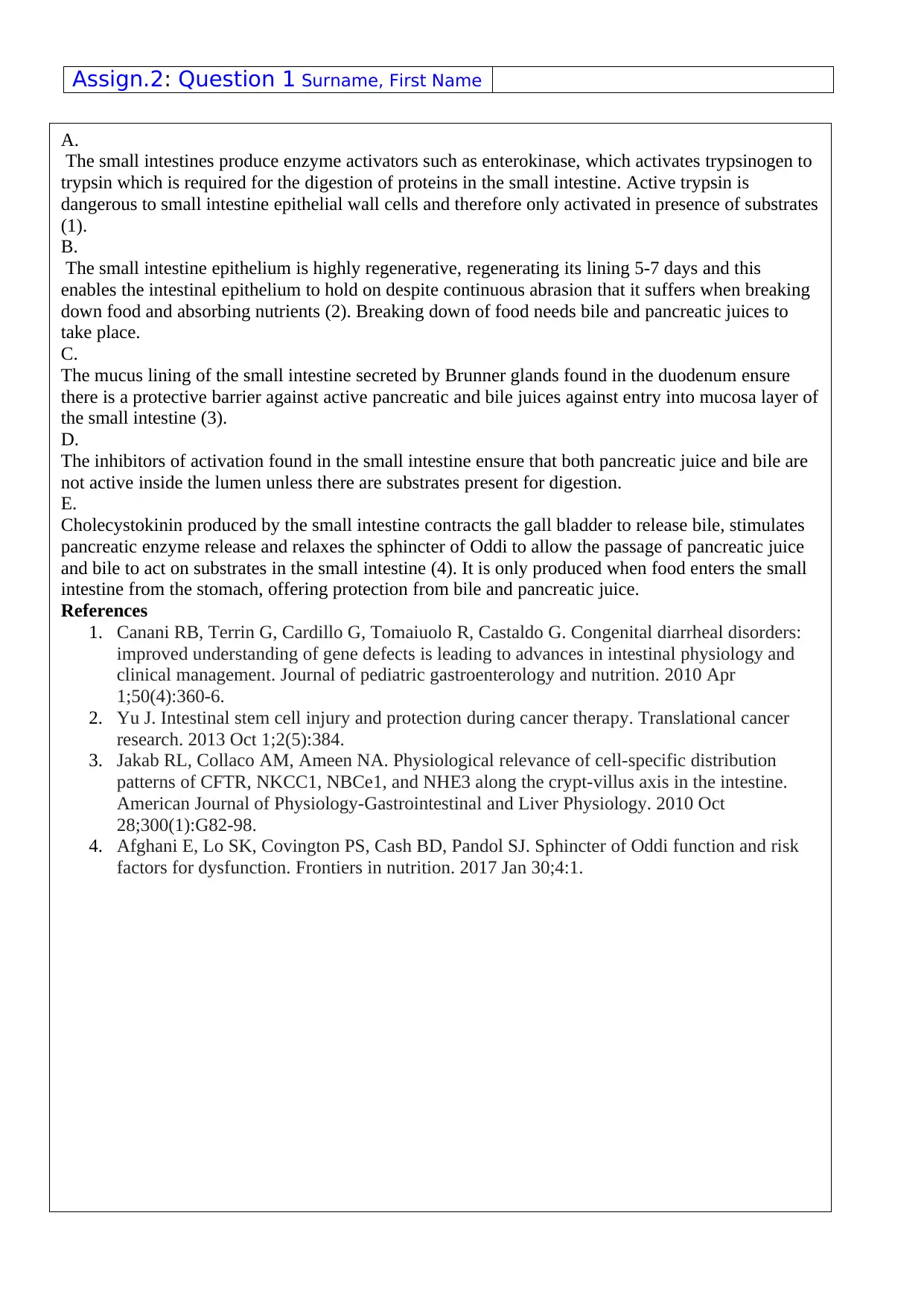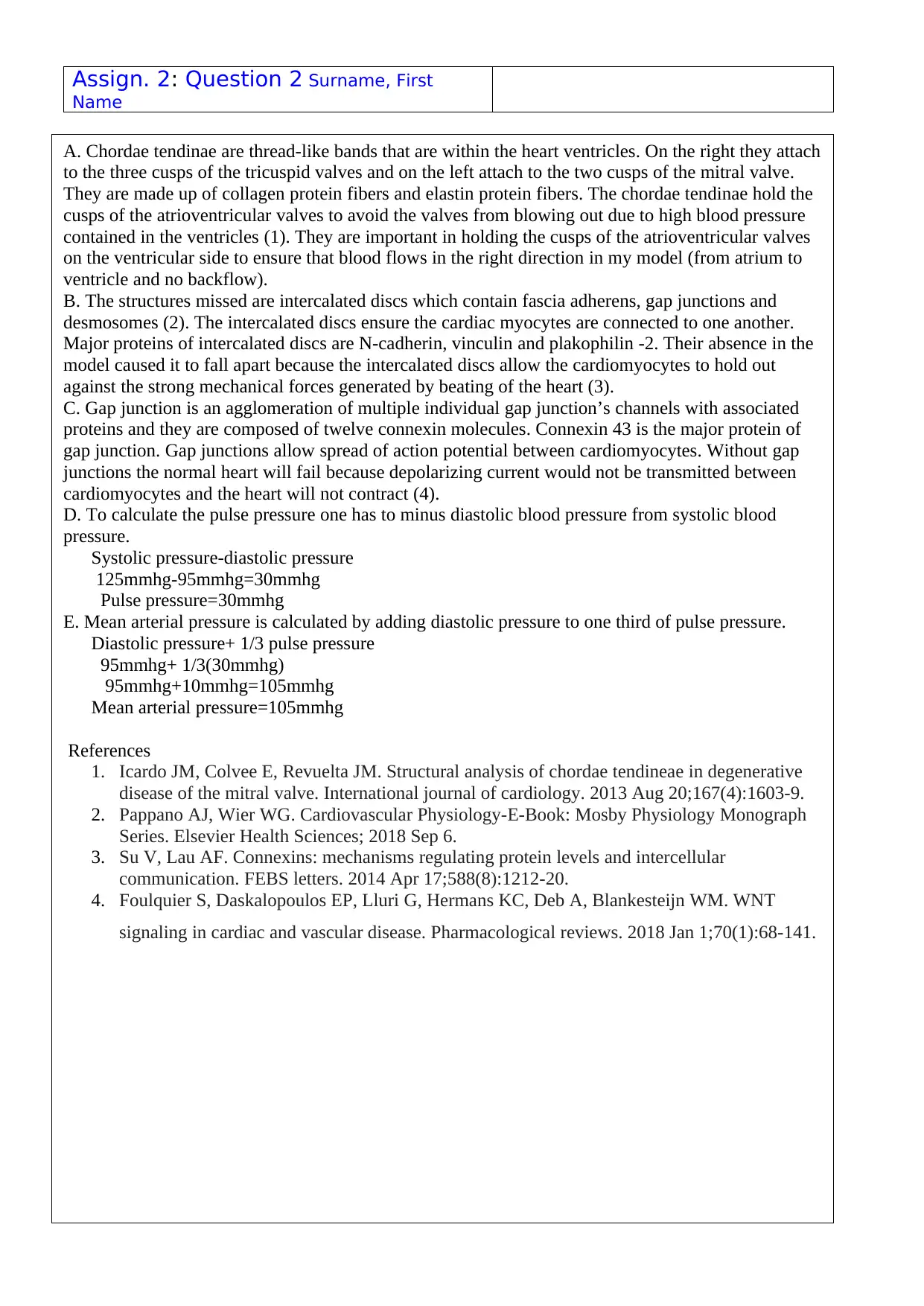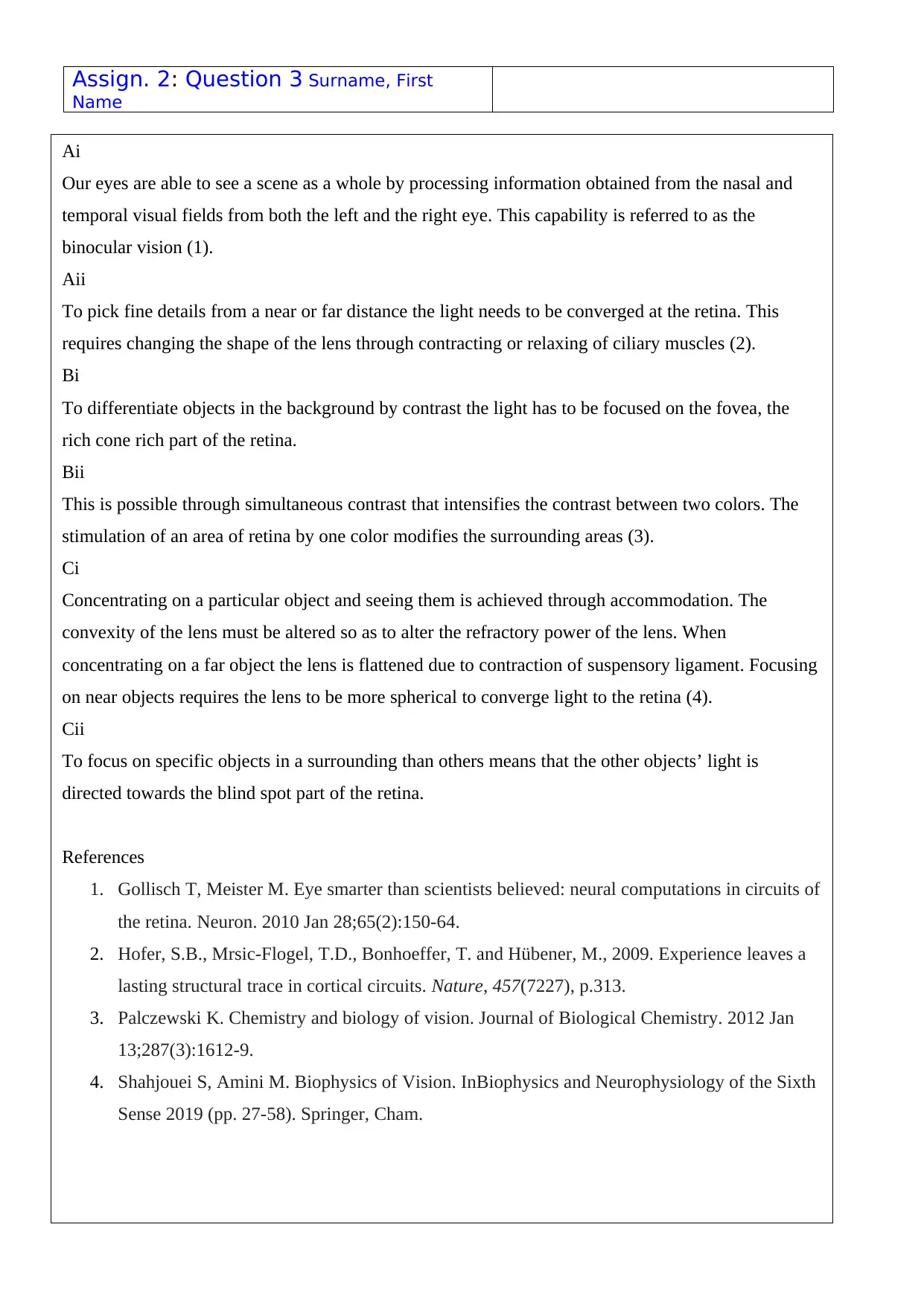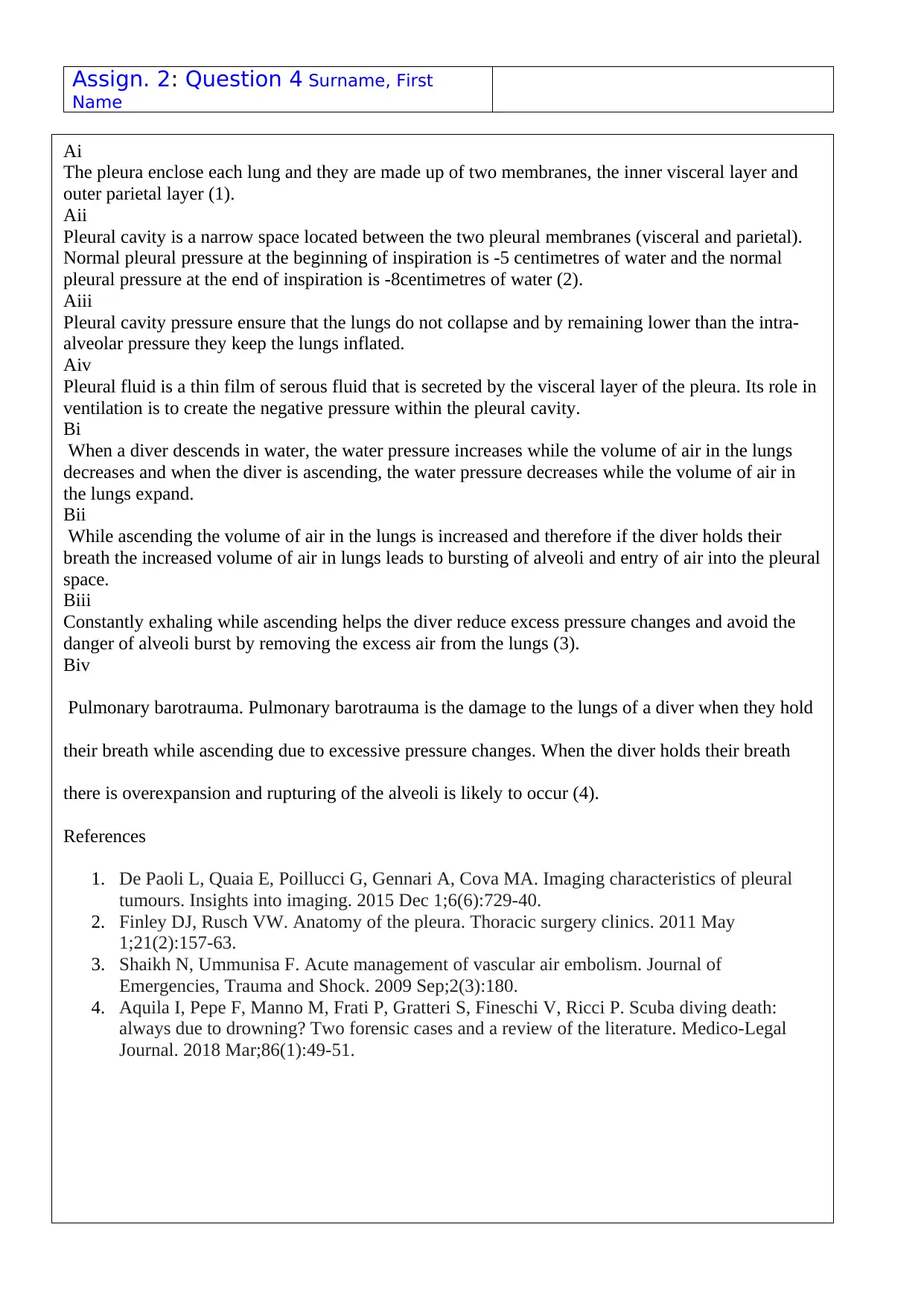MMED1005 How Your Body Works: Detailed Solutions for Assignment 2
VerifiedAdded on 2023/03/30
|4
|1428
|54
Homework Assignment
AI Summary
This document contains the solutions to Assignment 2 for the MMED1005 How Your Body Works course. It addresses questions related to the small intestine's protective mechanisms, the function of chordae tendinae and intercalated discs in the heart, the mechanisms of binocular vision and focusing, and the role of the pleura in lung function. The solutions provide detailed explanations and include references to support the answers, covering topics such as enzyme activation, tissue regeneration, cardiovascular physiology, and the biophysics of vision and respiration. Desklib offers this and more solved assignments to aid students in their studies.

Assign.2: Question 1 Surname, First Name
A.
The small intestines produce enzyme activators such as enterokinase, which activates trypsinogen to
trypsin which is required for the digestion of proteins in the small intestine. Active trypsin is
dangerous to small intestine epithelial wall cells and therefore only activated in presence of substrates
(1).
B.
The small intestine epithelium is highly regenerative, regenerating its lining 5-7 days and this
enables the intestinal epithelium to hold on despite continuous abrasion that it suffers when breaking
down food and absorbing nutrients (2). Breaking down of food needs bile and pancreatic juices to
take place.
C.
The mucus lining of the small intestine secreted by Brunner glands found in the duodenum ensure
there is a protective barrier against active pancreatic and bile juices against entry into mucosa layer of
the small intestine (3).
D.
The inhibitors of activation found in the small intestine ensure that both pancreatic juice and bile are
not active inside the lumen unless there are substrates present for digestion.
E.
Cholecystokinin produced by the small intestine contracts the gall bladder to release bile, stimulates
pancreatic enzyme release and relaxes the sphincter of Oddi to allow the passage of pancreatic juice
and bile to act on substrates in the small intestine (4). It is only produced when food enters the small
intestine from the stomach, offering protection from bile and pancreatic juice.
References
1. Canani RB, Terrin G, Cardillo G, Tomaiuolo R, Castaldo G. Congenital diarrheal disorders:
improved understanding of gene defects is leading to advances in intestinal physiology and
clinical management. Journal of pediatric gastroenterology and nutrition. 2010 Apr
1;50(4):360-6.
2. Yu J. Intestinal stem cell injury and protection during cancer therapy. Translational cancer
research. 2013 Oct 1;2(5):384.
3. Jakab RL, Collaco AM, Ameen NA. Physiological relevance of cell-specific distribution
patterns of CFTR, NKCC1, NBCe1, and NHE3 along the crypt-villus axis in the intestine.
American Journal of Physiology-Gastrointestinal and Liver Physiology. 2010 Oct
28;300(1):G82-98.
4. Afghani E, Lo SK, Covington PS, Cash BD, Pandol SJ. Sphincter of Oddi function and risk
factors for dysfunction. Frontiers in nutrition. 2017 Jan 30;4:1.
A.
The small intestines produce enzyme activators such as enterokinase, which activates trypsinogen to
trypsin which is required for the digestion of proteins in the small intestine. Active trypsin is
dangerous to small intestine epithelial wall cells and therefore only activated in presence of substrates
(1).
B.
The small intestine epithelium is highly regenerative, regenerating its lining 5-7 days and this
enables the intestinal epithelium to hold on despite continuous abrasion that it suffers when breaking
down food and absorbing nutrients (2). Breaking down of food needs bile and pancreatic juices to
take place.
C.
The mucus lining of the small intestine secreted by Brunner glands found in the duodenum ensure
there is a protective barrier against active pancreatic and bile juices against entry into mucosa layer of
the small intestine (3).
D.
The inhibitors of activation found in the small intestine ensure that both pancreatic juice and bile are
not active inside the lumen unless there are substrates present for digestion.
E.
Cholecystokinin produced by the small intestine contracts the gall bladder to release bile, stimulates
pancreatic enzyme release and relaxes the sphincter of Oddi to allow the passage of pancreatic juice
and bile to act on substrates in the small intestine (4). It is only produced when food enters the small
intestine from the stomach, offering protection from bile and pancreatic juice.
References
1. Canani RB, Terrin G, Cardillo G, Tomaiuolo R, Castaldo G. Congenital diarrheal disorders:
improved understanding of gene defects is leading to advances in intestinal physiology and
clinical management. Journal of pediatric gastroenterology and nutrition. 2010 Apr
1;50(4):360-6.
2. Yu J. Intestinal stem cell injury and protection during cancer therapy. Translational cancer
research. 2013 Oct 1;2(5):384.
3. Jakab RL, Collaco AM, Ameen NA. Physiological relevance of cell-specific distribution
patterns of CFTR, NKCC1, NBCe1, and NHE3 along the crypt-villus axis in the intestine.
American Journal of Physiology-Gastrointestinal and Liver Physiology. 2010 Oct
28;300(1):G82-98.
4. Afghani E, Lo SK, Covington PS, Cash BD, Pandol SJ. Sphincter of Oddi function and risk
factors for dysfunction. Frontiers in nutrition. 2017 Jan 30;4:1.
Paraphrase This Document
Need a fresh take? Get an instant paraphrase of this document with our AI Paraphraser

Assign. 2: Question 2 Surname, First
Name
A. Chordae tendinae are thread-like bands that are within the heart ventricles. On the right they attach
to the three cusps of the tricuspid valves and on the left attach to the two cusps of the mitral valve.
They are made up of collagen protein fibers and elastin protein fibers. The chordae tendinae hold the
cusps of the atrioventricular valves to avoid the valves from blowing out due to high blood pressure
contained in the ventricles (1). They are important in holding the cusps of the atrioventricular valves
on the ventricular side to ensure that blood flows in the right direction in my model (from atrium to
ventricle and no backflow).
B. The structures missed are intercalated discs which contain fascia adherens, gap junctions and
desmosomes (2). The intercalated discs ensure the cardiac myocytes are connected to one another.
Major proteins of intercalated discs are N-cadherin, vinculin and plakophilin -2. Their absence in the
model caused it to fall apart because the intercalated discs allow the cardiomyocytes to hold out
against the strong mechanical forces generated by beating of the heart (3).
C. Gap junction is an agglomeration of multiple individual gap junction’s channels with associated
proteins and they are composed of twelve connexin molecules. Connexin 43 is the major protein of
gap junction. Gap junctions allow spread of action potential between cardiomyocytes. Without gap
junctions the normal heart will fail because depolarizing current would not be transmitted between
cardiomyocytes and the heart will not contract (4).
D. To calculate the pulse pressure one has to minus diastolic blood pressure from systolic blood
pressure.
Systolic pressure-diastolic pressure
125mmhg-95mmhg=30mmhg
Pulse pressure=30mmhg
E. Mean arterial pressure is calculated by adding diastolic pressure to one third of pulse pressure.
Diastolic pressure+ 1/3 pulse pressure
95mmhg+ 1/3(30mmhg)
95mmhg+10mmhg=105mmhg
Mean arterial pressure=105mmhg
References
1. Icardo JM, Colvee E, Revuelta JM. Structural analysis of chordae tendineae in degenerative
disease of the mitral valve. International journal of cardiology. 2013 Aug 20;167(4):1603-9.
2. Pappano AJ, Wier WG. Cardiovascular Physiology-E-Book: Mosby Physiology Monograph
Series. Elsevier Health Sciences; 2018 Sep 6.
3. Su V, Lau AF. Connexins: mechanisms regulating protein levels and intercellular
communication. FEBS letters. 2014 Apr 17;588(8):1212-20.
4. Foulquier S, Daskalopoulos EP, Lluri G, Hermans KC, Deb A, Blankesteijn WM. WNT
signaling in cardiac and vascular disease. Pharmacological reviews. 2018 Jan 1;70(1):68-141.
Name
A. Chordae tendinae are thread-like bands that are within the heart ventricles. On the right they attach
to the three cusps of the tricuspid valves and on the left attach to the two cusps of the mitral valve.
They are made up of collagen protein fibers and elastin protein fibers. The chordae tendinae hold the
cusps of the atrioventricular valves to avoid the valves from blowing out due to high blood pressure
contained in the ventricles (1). They are important in holding the cusps of the atrioventricular valves
on the ventricular side to ensure that blood flows in the right direction in my model (from atrium to
ventricle and no backflow).
B. The structures missed are intercalated discs which contain fascia adherens, gap junctions and
desmosomes (2). The intercalated discs ensure the cardiac myocytes are connected to one another.
Major proteins of intercalated discs are N-cadherin, vinculin and plakophilin -2. Their absence in the
model caused it to fall apart because the intercalated discs allow the cardiomyocytes to hold out
against the strong mechanical forces generated by beating of the heart (3).
C. Gap junction is an agglomeration of multiple individual gap junction’s channels with associated
proteins and they are composed of twelve connexin molecules. Connexin 43 is the major protein of
gap junction. Gap junctions allow spread of action potential between cardiomyocytes. Without gap
junctions the normal heart will fail because depolarizing current would not be transmitted between
cardiomyocytes and the heart will not contract (4).
D. To calculate the pulse pressure one has to minus diastolic blood pressure from systolic blood
pressure.
Systolic pressure-diastolic pressure
125mmhg-95mmhg=30mmhg
Pulse pressure=30mmhg
E. Mean arterial pressure is calculated by adding diastolic pressure to one third of pulse pressure.
Diastolic pressure+ 1/3 pulse pressure
95mmhg+ 1/3(30mmhg)
95mmhg+10mmhg=105mmhg
Mean arterial pressure=105mmhg
References
1. Icardo JM, Colvee E, Revuelta JM. Structural analysis of chordae tendineae in degenerative
disease of the mitral valve. International journal of cardiology. 2013 Aug 20;167(4):1603-9.
2. Pappano AJ, Wier WG. Cardiovascular Physiology-E-Book: Mosby Physiology Monograph
Series. Elsevier Health Sciences; 2018 Sep 6.
3. Su V, Lau AF. Connexins: mechanisms regulating protein levels and intercellular
communication. FEBS letters. 2014 Apr 17;588(8):1212-20.
4. Foulquier S, Daskalopoulos EP, Lluri G, Hermans KC, Deb A, Blankesteijn WM. WNT
signaling in cardiac and vascular disease. Pharmacological reviews. 2018 Jan 1;70(1):68-141.

Assign. 2: Question 3 Surname, First
Name
Ai
Our eyes are able to see a scene as a whole by processing information obtained from the nasal and
temporal visual fields from both the left and the right eye. This capability is referred to as the
binocular vision (1).
Aii
To pick fine details from a near or far distance the light needs to be converged at the retina. This
requires changing the shape of the lens through contracting or relaxing of ciliary muscles (2).
Bi
To differentiate objects in the background by contrast the light has to be focused on the fovea, the
rich cone rich part of the retina.
Bii
This is possible through simultaneous contrast that intensifies the contrast between two colors. The
stimulation of an area of retina by one color modifies the surrounding areas (3).
Ci
Concentrating on a particular object and seeing them is achieved through accommodation. The
convexity of the lens must be altered so as to alter the refractory power of the lens. When
concentrating on a far object the lens is flattened due to contraction of suspensory ligament. Focusing
on near objects requires the lens to be more spherical to converge light to the retina (4).
Cii
To focus on specific objects in a surrounding than others means that the other objects’ light is
directed towards the blind spot part of the retina.
References
1. Gollisch T, Meister M. Eye smarter than scientists believed: neural computations in circuits of
the retina. Neuron. 2010 Jan 28;65(2):150-64.
2. Hofer, S.B., Mrsic-Flogel, T.D., Bonhoeffer, T. and Hübener, M., 2009. Experience leaves a
lasting structural trace in cortical circuits. Nature, 457(7227), p.313.
3. Palczewski K. Chemistry and biology of vision. Journal of Biological Chemistry. 2012 Jan
13;287(3):1612-9.
4. Shahjouei S, Amini M. Biophysics of Vision. InBiophysics and Neurophysiology of the Sixth
Sense 2019 (pp. 27-58). Springer, Cham.
Name
Ai
Our eyes are able to see a scene as a whole by processing information obtained from the nasal and
temporal visual fields from both the left and the right eye. This capability is referred to as the
binocular vision (1).
Aii
To pick fine details from a near or far distance the light needs to be converged at the retina. This
requires changing the shape of the lens through contracting or relaxing of ciliary muscles (2).
Bi
To differentiate objects in the background by contrast the light has to be focused on the fovea, the
rich cone rich part of the retina.
Bii
This is possible through simultaneous contrast that intensifies the contrast between two colors. The
stimulation of an area of retina by one color modifies the surrounding areas (3).
Ci
Concentrating on a particular object and seeing them is achieved through accommodation. The
convexity of the lens must be altered so as to alter the refractory power of the lens. When
concentrating on a far object the lens is flattened due to contraction of suspensory ligament. Focusing
on near objects requires the lens to be more spherical to converge light to the retina (4).
Cii
To focus on specific objects in a surrounding than others means that the other objects’ light is
directed towards the blind spot part of the retina.
References
1. Gollisch T, Meister M. Eye smarter than scientists believed: neural computations in circuits of
the retina. Neuron. 2010 Jan 28;65(2):150-64.
2. Hofer, S.B., Mrsic-Flogel, T.D., Bonhoeffer, T. and Hübener, M., 2009. Experience leaves a
lasting structural trace in cortical circuits. Nature, 457(7227), p.313.
3. Palczewski K. Chemistry and biology of vision. Journal of Biological Chemistry. 2012 Jan
13;287(3):1612-9.
4. Shahjouei S, Amini M. Biophysics of Vision. InBiophysics and Neurophysiology of the Sixth
Sense 2019 (pp. 27-58). Springer, Cham.
⊘ This is a preview!⊘
Do you want full access?
Subscribe today to unlock all pages.

Trusted by 1+ million students worldwide

Assign. 2: Question 4 Surname, First
Name
Ai
The pleura enclose each lung and they are made up of two membranes, the inner visceral layer and
outer parietal layer (1).
Aii
Pleural cavity is a narrow space located between the two pleural membranes (visceral and parietal).
Normal pleural pressure at the beginning of inspiration is -5 centimetres of water and the normal
pleural pressure at the end of inspiration is -8centimetres of water (2).
Aiii
Pleural cavity pressure ensure that the lungs do not collapse and by remaining lower than the intra-
alveolar pressure they keep the lungs inflated.
Aiv
Pleural fluid is a thin film of serous fluid that is secreted by the visceral layer of the pleura. Its role in
ventilation is to create the negative pressure within the pleural cavity.
Bi
When a diver descends in water, the water pressure increases while the volume of air in the lungs
decreases and when the diver is ascending, the water pressure decreases while the volume of air in
the lungs expand.
Bii
While ascending the volume of air in the lungs is increased and therefore if the diver holds their
breath the increased volume of air in lungs leads to bursting of alveoli and entry of air into the pleural
space.
Biii
Constantly exhaling while ascending helps the diver reduce excess pressure changes and avoid the
danger of alveoli burst by removing the excess air from the lungs (3).
Biv
Pulmonary barotrauma. Pulmonary barotrauma is the damage to the lungs of a diver when they hold
their breath while ascending due to excessive pressure changes. When the diver holds their breath
there is overexpansion and rupturing of the alveoli is likely to occur (4).
References
1. De Paoli L, Quaia E, Poillucci G, Gennari A, Cova MA. Imaging characteristics of pleural
tumours. Insights into imaging. 2015 Dec 1;6(6):729-40.
2. Finley DJ, Rusch VW. Anatomy of the pleura. Thoracic surgery clinics. 2011 May
1;21(2):157-63.
3. Shaikh N, Ummunisa F. Acute management of vascular air embolism. Journal of
Emergencies, Trauma and Shock. 2009 Sep;2(3):180.
4. Aquila I, Pepe F, Manno M, Frati P, Gratteri S, Fineschi V, Ricci P. Scuba diving death:
always due to drowning? Two forensic cases and a review of the literature. Medico-Legal
Journal. 2018 Mar;86(1):49-51.
Name
Ai
The pleura enclose each lung and they are made up of two membranes, the inner visceral layer and
outer parietal layer (1).
Aii
Pleural cavity is a narrow space located between the two pleural membranes (visceral and parietal).
Normal pleural pressure at the beginning of inspiration is -5 centimetres of water and the normal
pleural pressure at the end of inspiration is -8centimetres of water (2).
Aiii
Pleural cavity pressure ensure that the lungs do not collapse and by remaining lower than the intra-
alveolar pressure they keep the lungs inflated.
Aiv
Pleural fluid is a thin film of serous fluid that is secreted by the visceral layer of the pleura. Its role in
ventilation is to create the negative pressure within the pleural cavity.
Bi
When a diver descends in water, the water pressure increases while the volume of air in the lungs
decreases and when the diver is ascending, the water pressure decreases while the volume of air in
the lungs expand.
Bii
While ascending the volume of air in the lungs is increased and therefore if the diver holds their
breath the increased volume of air in lungs leads to bursting of alveoli and entry of air into the pleural
space.
Biii
Constantly exhaling while ascending helps the diver reduce excess pressure changes and avoid the
danger of alveoli burst by removing the excess air from the lungs (3).
Biv
Pulmonary barotrauma. Pulmonary barotrauma is the damage to the lungs of a diver when they hold
their breath while ascending due to excessive pressure changes. When the diver holds their breath
there is overexpansion and rupturing of the alveoli is likely to occur (4).
References
1. De Paoli L, Quaia E, Poillucci G, Gennari A, Cova MA. Imaging characteristics of pleural
tumours. Insights into imaging. 2015 Dec 1;6(6):729-40.
2. Finley DJ, Rusch VW. Anatomy of the pleura. Thoracic surgery clinics. 2011 May
1;21(2):157-63.
3. Shaikh N, Ummunisa F. Acute management of vascular air embolism. Journal of
Emergencies, Trauma and Shock. 2009 Sep;2(3):180.
4. Aquila I, Pepe F, Manno M, Frati P, Gratteri S, Fineschi V, Ricci P. Scuba diving death:
always due to drowning? Two forensic cases and a review of the literature. Medico-Legal
Journal. 2018 Mar;86(1):49-51.
1 out of 4
Your All-in-One AI-Powered Toolkit for Academic Success.
+13062052269
info@desklib.com
Available 24*7 on WhatsApp / Email
![[object Object]](/_next/static/media/star-bottom.7253800d.svg)
Unlock your academic potential
Copyright © 2020–2025 A2Z Services. All Rights Reserved. Developed and managed by ZUCOL.